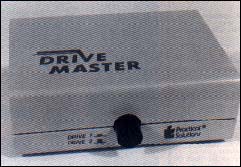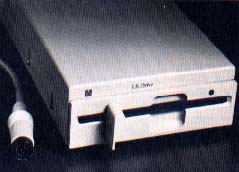Mac and PC On The ST
Setting Up pc-ditto, Part II
by David Plotkin
 |
The Drive Master is a must-have for those users of pc-ditto who have a 5 1/4-inch drive and an external 3 1/2-inch drive. It's a small box that lets you switch easily between the two dissimilar disk drives. |
Hello! Starting this issue, I'm taking over the Mac/PC column for START. I want to thank Jim Pierson-Perry not only for his nice introduction last month, but also for getting this column off to a strong start. I hope to keep the quality of this column up to his high standards.
Last issue, Jim discussed setting up pc-ditto on your ST; this issue, I'll expand on that theme and talk about two pieces of hardware that'll make your life with pc-ditto a little easier.
Continuing On
Last time, Jim talked about how to set up and use a hard drive with pc-ditto, including how to set up a CONFIG.SYS which tells your ST how your various devices are configured. (By the way, when I mention DOS in this column I will be referring to MS-DOS, published by Microsoft, and PC-DOS, published by IBM. I do not recommend using a DOS tailored for a PC clone.)
But what about floppy drives? The section in the pc-ditto manual that deals with configuring floppies is a little hazy, because limitations of DOS make this subject more complicated than it really should have been. With DOS 3.2, you had the ability to modify the drive parameter table, so if you had, say, a single-sided 3 1/2-inch drive as drive B, you could simply add the lines detailed in the manual (such as "DRIVPARM= /D:1/T:80/S:9/H:1") to your CONFIG.SYS file. From then on, whenever you accessed your B drive, either to run a program or to format a disk, you'd be all set. This worked whether you had a hard drive or not.
With DOS 3.3, things became more complicated. No longer can you modify the drive parameter table. As detailed in the manual, you must declare new devices and add these lines to the CONFIG.SYS file (such as "DEVICE= DRIVER.SYS /D: 0/T:80/S:9/H:1"). When you do this, however, DOS creates a "new" disk drive with a new drive letter. Thus, if you have two floppies (A and B) and no hard drive, then placing two lines in your CONFIG.SYS file to set up your disk drives creates two new logical drives, C: and D:. To run programs from your drives, you access them as A: or B:, but to format them to their full capacity (360K single-sided and 720K double-sided), you must access them as drives C: and D:. Failing to do this will cause your double-sided drives to format as 40-track drives holding about 360K, regardless of their actual capacity!
Things become even more interesting with a hard drive. If it's installed properly (as Jim described), the new drives that are created by CONFIG.SYS must start where the hard drive leaves off. For example, my 50-megabyte hard drive is partitioned as drives C:, D:, E: and F:. My two floppies are a 5 1/4-inch external I.B. Drive (more on this) set up as my A drive, and the internal 3 1/2-inch double-sided drive configured as the B drive. However, after I install my system under DOS 3.3, I must refer to the B drive as drive G to format it properly!
CONFIG.SYS and AUTOEXEC.BAT
The CONFIG.SYS file contains instructions and configuration information about the system. We've already discussed the HD driver and the device definitions that need to be in this file.
My own file looks like this:
|
DEVICE=PC_DHD.SYS DEVICE = DRIVER.SYS /D: 1/F: 2 BUFFERS= 16 FILES= 25 |
HD driver 3 1/2-inch double-sided disk 16 buffers allocated allow 25 open files at once |
The last two lines will improve performance by holding disk-based information in memory. Line 2 establishes the characteristics of my B drive. Because my A drive is a standard IBM-style, 40-track, 5 1/4-inch drive, no special device definition. However, you would need a device definition line for each non-IBM-style (ST 3 1/2-inch) drive. Remember: the .SYS files specified by the CONFIG.SYS file such as PC_HD.SYS and DRIVER.SYS, must be present on your DOS boot disk. DRIVER.SYS is distributed with DOS, but PC_DHD.SYS comes with pc-ditto.
The AUTOEXEC.BAT file works similarly to the AUTO folder in GEM. It's quite versatile and allows you to execute a sequence of commands on startup which perform a series to tasks. My file looks like this:
|
PROMPT=$P$G PC_DMOUSE PCDSETTD |
Change the prompt style set up serial mouse driver get time and date from GEM |
The first line sets up the prompt. As you probably know by now, the normal prompt in DOS is a rather uninformative drive letter. The first line of this file tells the prompt to become the drive letter and current directory (folder in GEM talk). This way, you always know where you are. The prompt can be a message, the time and date or quite a few other things. The other two lines actually execute two small programs, whose purposes are indicated in the comments above.
Almost any program (that typically ends in .EXE, .PRG or .COM) can be executed just by typing its name at the prompt. There are all sorts of possibilities: custom startup screens, terminate-and-stay-resident programs, etc. (We'll go into Batch files in a future installment, since they're a programming language all in themselves.) The two programs in the above Batch file--PC_DMOUS.COM and PCSETTD.COM--must also be present on your DOS boot disk. You'll need to copy them from the pc-ditto disk.
 |
The I.B. 5 1/4-inch drive has a storage capacity of 360K and is invaluable when using pc-ditto. |
Plenty Of Drive
If you want the ultimate in convenience with pc-ditto, you'll want a 5 1/4-inch drive. There are several reasons for this. First, many PC programs are available only on 5 1/4-inch disks and if the software is copy-protected, you can't copy it to 3 1/2-inch disks. Some PC programs are available on 3 1/2-inch disks, but more and more these are the 1.44-megabyte quad-density disks used by IBM PS/2 machines rather than the regular 720K PC disks our STs can use. Also, while the ST can read disks formatted on a PC, pc-ditto cannot read disks formatted under GEM on the ST.
Enter the I.B. Drive, from I.B. Computers. It's a 5 1/4-inch drive with a capacity of 360K. A standard drive cable is attached to the back and the drive plugs into your ST's external drive port. Installation is simply a matter of plugging the cable in.
To use the drive, you must add a program called RES.PRG to your AUTO folder to slow down the stepping rate of the drive head. Unfortunately, the instructions (a single 8 1/2 by 11 sheet of paper) don't mention that a 5 1/4-inch disk must be in the drive with the door closed or your ST will refuse to boot. RES.PRG must also be the first program placed in your AUTO folder, which means you must empty the folder and rebuild it. (The documentation doesn't tell you this, either)
You can use another program called FMT.PRG to format a 5 1/4-inch disk (or you can use the FORMAT command under DOS from pc-ditto). The FMT.PRG cannot make a DOS system disk, so its of limited use to users of pc-ditto. It runs under TOS and many of the parameters are not explained; fortunately, the default parameters work.
Once you have formatted a 5 1/4-inch disk, you can work with it pretty much as you would your 3 1/2-inch drive. You can open a window to get a directory, run programs by double-clicking on them and copy or delete files.
Mastering Your Drives
Another of the practical solutions from the folks at--you guessed it: Practical Solutions--is the drive Master. This incredibly useful little device is a must-have for those users of pc-ditto who have a 5 1/4-inch drive and an external 3 1/2-inch drive. The Drive Master is a small box into which you can connect two drives. You then plug the Drive Master into your ST external drive port. A button on the front lets you switch between the two drives attached.
In my own configuration, my I.B. 5 1/4-inch and my double-sided 3 1/2-inch drives are connected to the drive Master. Switching between them is just a pushbutton away.
Now, why would you need to switch between drives? Well, envision the following scenario: pc-ditto has allowed you to set up your external I.B. Drive as drive A, so that copy-protected software that must run from drive A will be usable. Unfortunately, DOS must also be started from drive A. But DOS won't fit on one 5 1/4-inch disk--its distributed on two. It will fit on one 3 1/2-inch double sided disk.
Here's what you do. Set the drive Master to access your 3 1/2-inch double-sided drive. When pc-ditto requests you put the DOS disk in drive A, put the 3 1/2-inch disk in and press Return. After DOS loads, you can use Drive Master to switch over to the 5 1/4-inch drive.
Need DOS again? No sweat. Just switch back to the 3 1/2-inch drive. MSDOS will happily access either drive as A with no problems. The only thing to remember is that to format a double-sided 3 1/2-inch disk, you must use another drive. I use the internal drive on my Mega, which I must address as drive G (see above). The one complaint I have about Drive Master is that its difficult to discern between the two button positions, so I frequently access the wrong drive. I would have preferred a slide switch rather than a pushbutton. But drive Master makes using pc-ditto with a 5 1/4-inch drive much easier, and I highly recommend it for all ST users who have similar drive configurations.
Next month, well look at some tried-and-true PC utilities and other programs.
David Plotkin is a chemical engineer for Chevron U.S.A. and a long-time contributor to START and Antic.
Products Mentioned
IB Drive, $249.95. IB Computers, 1519 SW Marlow Ave., Portland, OR 97225, (503) 297-8425.
Drive Master, $39.95. Practical Solutions, 1930 E. Grant Rd., Tucson, AZ 85716, (602) 884-9612.